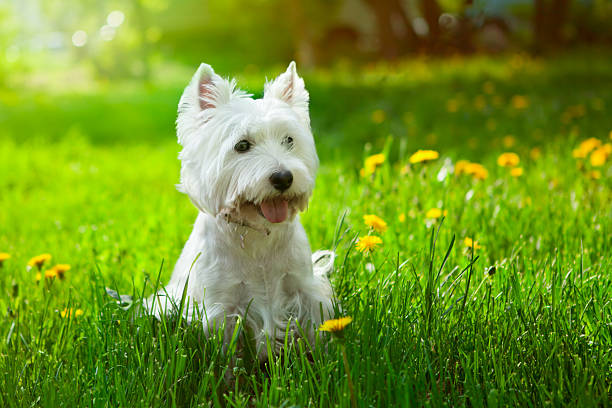West Highland White Terrier

Breed History:
The West Highland White Terrier originated in Scotland, where it was developed to hunt rats, foxes, and other small game in rugged terrain. It shares ancestry with other Scottish terriers like the Cairn, Skye, and Scottish Terrier.
Legend holds that the breed’s distinctive white coat was intentionally bred by Colonel Edward Donald Malcolm in the 19th century after he accidentally shot a darker-colored terrier during a hunt. The white coat made the dog more visible in the field.
The Westie was recognised by the Kennel Club (UK) in 1906 and the AKC in 1908. Today, it is beloved as both a lively companion and a show dog.
|
Gender |
Height |
Weight |
|
Male |
25-28 cm |
7-10 kg |
|
Female |
23-27 cm |
6-8 kg |
Size – Small
Life Expectancy: 13–15 years

Breed Appearance:
The Westie is a compact, sturdy terrier with a deep chest, strong legs, and a level topline. Its face is expressive, with dark almond-shaped eyes and small, erect ears.
The breed’s trademark is its harsh, straight, white double coat, with a soft undercoat and profuse furnishings around the face and legs. Its tail is short, carrot-shaped, and carried upright.
Breed Type – Companion/Ratter:
Originally bred as a working terrier, the Westie retains its feisty, confident, and curious personality. It is bold without being aggressive and has a strong prey drive.
Westies are affectionate with their families and often do well with older children. They are alert and independent, making them both fun and occasionally stubborn companions.

Training:
Westies are intelligent but independent-minded, so early and consistent training is important. Use positive reinforcement, short sessions, and variety to keep them engaged.
They benefit from early socialisation to avoid excessive barking or wariness of strangers. Obedience, rally, and agility training help focus their energy.
Health & Care:
Generally a healthy breed, but prone to certain conditions:
-
Skin allergies (atopic dermatitis)
-
Legg-Calvé-Perthes disease
-
Patellar luxation
-
Craniomandibular osteopathy (puppy jaw)
-
Pulmonary fibrosis (rare but serious)
Regular grooming, skin care, and a high-quality diet support long-term health. Choose breeders who screen for hereditary issues.

Living Conditions:
Westies adapt well to apartments or homes, provided they get daily exercise. They do best in households where they are not left alone for long periods.
They enjoy companionship and can be territorial or vocal if under-stimulated. A secure yard is ideal, but not necessary, with enough mental and physical activity.
Exercise:
Daily exercise is important—aim for 30–60 minutes of walking, playtime, or indoor games. Westies love to dig and chase, so interactive toys and games that mimic hunting instincts are ideal.
They have bursts of high energy but are also content to relax with their people afterwards.
Grooming:
-
Moderate grooming needs
-
Brush 2–3 times per week to prevent matting and remove debris
-
Professional grooming or hand-stripping every 6–8 weeks
-
Regular ear cleaning, nail trimming, and dental care
They are moderate shedders and require upkeep to maintain their iconic look.

Advantages:
-
Cheerful, confident, and affectionate
-
Adaptable to most living environments
-
Naturally clean and low odour
-
Good watchdog with alert instincts
-
Long lifespan and generally healthy
-
Distinctive, charming appearance
Disadvantages:
-
Strong prey drive—not ideal with small pets
-
Can be barky or territorial
-
Prone to skin issues and allergies
-
Needs regular grooming and coat maintenance
-
May be stubborn or independent during training
-
Needs daily mental and physical stimulation

